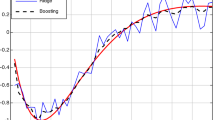Abstract
Various forms of additive modeling techniques have been successfully used in many data mining and machine learning–related applications. In spite of their great success, boosting algorithms still suffer from a few open-ended problems that require closer investigation. The efficiency of any additive modeling technique relies significantly on the choice of the weak learners and the form of the loss function. In this paper, we propose a novel multi-resolution approach for choosing the weak learners during additive modeling. Our method applies insights from multi-resolution analysis and chooses the optimal learners at multiple resolutions during different iterations of the boosting algorithms, which are simple yet powerful additive modeling methods. We demonstrate the advantages of this novel framework in both classification and regression problems and show results on both synthetic and real-world datasets taken from the UCI machine learning repository. Though demonstrated specifically in the context of boosting algorithms, our framework can be easily accommodated in general additive modeling techniques. Similarities and distinctions of the proposed algorithm with the popularly used methods like radial basis function networks are also discussed.
Similar content being viewed by others
References
Allwein E, Schapire R, Singer Y (2001) Reducing multiclass to binary: a unifying approach for margin classifiers. J Mach Learn Res 1: 113–141
Athitsos V, Alon J, Sclaroff S, Kollios G (2008) Boostmap: an embedding method for efficient nearest neighbor retrieval. IEEE Trans Pattern Anal Mach Intell 30(1): 89–104
Bauer E, Kohavi R (1999) An empirical comparison of voting classification algorithms: bagging, boosting, and variants. Mach Learn 36(1–2): 105–139
Bishop CM (1995) Neural networks for pattern recognition. Oxford University Press, Oxford
Blake CL, Merz CJ (1998) UCI repository of machine learning databases. http://www.ics.uci.edu/mlearn/MLRepository.html, University of California, Irvine, Deptartment of Information and Computer Sciences
Breiman L (1996) Bagging predictors. Mach Learn 24(2): 123–140
Breiman L (1998) Arcing classifiers. Ann Stat 26(3): 801–849
Buhlmann P, Yu B (2003) Boosting with the l2 loss: regression and classification. J Am Stat Assoc 98(462): 324–339
Collins M, Schapire RE, Singer Y (2002) Logistic regression, adaboost and bregman distances. Mach Learn 48(1–3): 253–285
Duffy N, Helmbold D (2000) Leveraging for regression. In: Proceedings of 13th annual conference on computational learning theory. pp 208–219
Friedman JH (2001) Greedy function approximation: a gradient boosting machine. Ann Stat 29(5): 1189–1232
Friedman JH, Hastie T, Tibshirani R (2000) Additive logistic regression: a statistical view of boosting. Ann Stat 28(2): 337–407
Fritzke B (1994) Fast learning with incremental RBF networks. Neural Process Lett 1(1): 2–5
Graps AL (1995) An introduction to wavelets. IEEE Comput Sci Eng 2(2): 50–61
Hastie T, Tibshirani R, Friedman J (2001) The elements of statistical learning. Data mining, inference, and prediction, chapter boosting and additive trees. Springer, New York
Hong P, Liu XS, Zhou Q, Lu X, Liu JS, Wong WH (2005) A boosting approach for motif modeling using chip-chip data. Bioinformatics 21(11): 2636–2643
Kadiyala S, Shiri N (2008) A compact multi-resolution index for variable length queries in time series databases. Knowl Inf Syst 15(2): 131–147
Krishnaraj Y, Reddy CK (2008) Boosting methods for protein fold recognition: an empirical comparison. In: IEEE International Conference on Bioinformatics and Biomedicine. pp 393–396
Leung Y, Zhang J, Xu Z (2000) Clustering by scale-space filtering. IEEE Trans Pattern Anal Mach Intell 22(12): 1396–1410
Lindeberg T (1994) Scale-space theory in computer vision. Kluwer Academic Publishers, Dordrecht
Mallat S (1989) A theory for multiresolution signal decomposition: the wavelet representation. IEEE Trans Pattern Anal Mach Intell 11: 674–693
National Institute of Standards Information Technology Laboratory and Technology (NIST). Nist strd (statistics reference datasets). http://www.itl.nist.gov/div898/strd/
Park D (2009) Multiresolution-based bilinear recurrent neural network. Knowl Inf Syst 19(2): 235–248
Park J-H, Reddy CK (2007) Scale-space based boosting for weak regressors. In: Proceedings of European Conference on Machine Learning, (ECML ’07). Warsaw, Poland, pp 666–673
Preisach C, Schmidt-Thieme L (2008) Ensembles of relational classifiers. Knowl Inf Syst 14(3): 249–272
Reddy CK, Park J-H (2008) Scale-space kernels for additive modeling. In: Joint IAPR international workshop on structural syntactic and statistical pattern recognition (SSPR & SPR). Orlando, USA, p. 714–723
Reddy CK, Park J-H (2009) Multi-resolution boosting for classification and regression problems. In: Proceedings of Pacific-Asia conference on knowledge discovery and data mining (PAKDD). Bangkok, Thailand, pp 196–207
Rudin C, Schapire RE, Daubechies I (2007) Analysis of boosting algorithms using the smooth margin function. Ann Stat 35(6): 2723–2768
Schapire R, Singer Y, Singhal A (1998) Boosting and rocchio applied to text filtering. In: Proceedings of ACM SIGIR. pp 215–223
Schapire RE, Freund Y, Bartlett P, Lee WS (1998) Boosting the margin: a new explanation for the effectiveness of voting methods. Ann Stat 26(5): 1651–1686
Schapire RE, Singer Y (1999) Improved boosting using confidence-rated predictions. Mach Learn 37(3): 297–336
Sporring J, Nielsen M, Florack L, Johansen P (1997) Gaussian scale-space theory. Kluwer Academic Publishers, Dordrecht
Tieu K, Viola PA (2004) Boosting image retrieval. Int J Comput Vis 56(1–2): 17–36
Viola PA, Jones MJ (2004) Robust real-time face detection. Int J Comput Vis 57(2): 137–154
Webb GI (2000) Multiboosting: a technique for combining boosting and wagging. Mach Learn 40(2): 159–196
Witten IH, Frank E (2005) Data mining: practical machine learning tools and techniques, 2nd edn. Morgan Kaufmann, Los Altos
Zemel RS, Pitassi T (2000) A gradient-based boosting algorithm for regression problems. In: Neural information processing systems. pp 696–702
Zhu J, Rosset S, Zou H, Hastie T (2005) Multi-class adaboost. Technical Report 430, Department of Statistics, University of Michigan
Author information
Authors and Affiliations
Corresponding author
Rights and permissions
About this article
Cite this article
Reddy, C.K., Park, JH. Multi-resolution boosting for classification and regression problems. Knowl Inf Syst 29, 435–456 (2011). https://doi.org/10.1007/s10115-010-0358-0
Received:
Revised:
Accepted:
Published:
Issue Date:
DOI: https://doi.org/10.1007/s10115-010-0358-0




